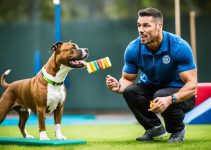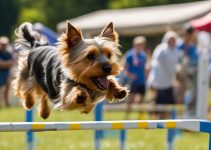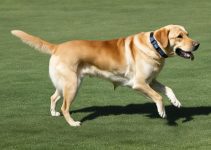Hello, fellow dog enthusiasts! If you are a proud owner of an English Cocker Spaniel or are considering adding one to your family, you’ve come to the right place. In this article, I will share some valuable tips on how to effectively train your English Cocker Spaniel using positive reinforcement techniques. With their intelligence, loyalty, and eagerness to please, Cocker Spaniels are a joy to train. So, let’s dive in and discover the secrets to successful English Cocker Spaniel training!
English Cocker Spaniel Training
- Consistency and patience are vital in English Cocker Spaniel training.
- Invest in the right training equipment for optimal results.
- Understand the unique qualities and talents of Cocker Spaniels.
- Teach basic commands and focus on behavioral training.
- Start socialization and training in early puppyhood.
The Basics of Cocker Spaniel Training
When it comes to English Cocker Spaniel training, mastering the basics is essential. By teaching them fundamental commands and behaviors, you can establish a solid foundation for obedience and good manners. Here are the key aspects to focus on:
1. Cocker Spaniel Commands
Teaching specific commands is crucial for effective training. Start with simple commands like sit, lie down, and come. Once your Cocker Spaniel has mastered these, you can progress to more advanced commands such as walking nicely on a leash, playing fetch, and sleeping in a crate. Remember to be consistent, patient, and use positive reinforcement techniques to encourage learning.
2. Puppy Training
Early English Cocker Spaniel training is vital for puppies as they are more receptive to learning at a young age. Socialize your Cocker Spaniel puppy by exposing them to different people, animals, and environments. This will help them develop good behavior and adaptability. Start teaching basic commands and establishing a routine that includes regular meals, potty breaks, and playtime.
3. Clicker Training
Clicker training is a popular positive reinforcement technique that can be highly effective for Cocker Spaniels. It involves using a clicker to mark desired behaviors and then rewarding the dog with treats. By associating the sound of the clicker with positive outcomes, your Cocker Spaniel will quickly learn new commands and behaviors.
4. Behavioral Training
Cocker Spaniels, like any dog breed, may exhibit certain behavioral issues that require additional training. Whether it’s addressing separation anxiety, excessive barking, or destructive chewing, behavioral training can help modify and redirect unwanted behaviors. Seek professional guidance if needed to understand the underlying causes and implement effective strategies.
By focusing on these basic aspects of English Cocker Spaniel training, you can establish a strong bond with your Cocker Spaniel and ensure a well-behaved and obedient companion.
Socialization and Training in Early Puppyhood
Socialization plays a crucial role in the English Cocker Spaniel training, especially during their early puppyhood. It is essential to expose them to a variety of people, animals, and environments to help them develop good behavior and communication skills.
When bringing home an English Cocker Spaniel puppy, starting their training as soon as possible is key. By beginning training early, you can focus on teaching them basic commands and establishing a routine that will set a solid foundation for their future training and behavior.
During their early puppyhood, it’s important to create positive experiences for your Cocker Spaniel. Introduce them to different environments, such as parks, streets, and other social settings, to ensure they become comfortable and adaptable in various situations. Engage them in interactive play with other well-behaved dogs to enhance their social skills.
Additionally, exposing your Cocker Spaniel to different stimuli, such as traffic noise, vacuum cleaners, and other everyday sounds, will help them become more resilient and less prone to fear or anxiety. This exposure should be done gradually, ensuring that your puppy feels safe and supported throughout the process.
Puppy training classes can be a great resource for socialization and training. These classes provide structured environments where your Cocker Spaniel can interact with other puppies and learn essential social skills under the guidance of a professional trainer.
Remember, consistency, patience, and positive reinforcement are key throughout the English Cocker Spaniel training process. Encourage and reward good behavior, and be consistent in your expectations. By investing time and effort into socializing and training your Cocker Spaniel during their early puppyhood, you are setting them up for a lifetime of well-rounded behavior and companionship.
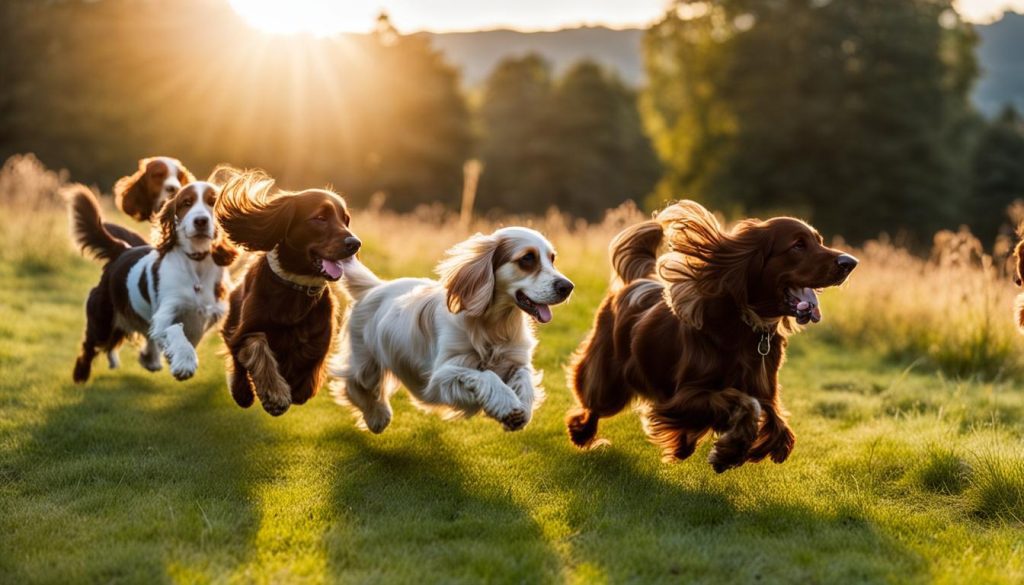
Crate and House Training Tips
When it comes to crate and house training your Cocker Spaniel, consistency and positive reinforcement are key. Crate training is an invaluable tool for housebreaking and providing a safe space for your furry friend. By following these tips, you can ensure a smooth and successful training process.
Introduce the Crate Gradually
Start by making the crate comfortable and inviting for your Cocker Spaniel. Place soft bedding and a few toys inside to create a cozy environment. Next, introduce your pup to the crate gradually. Leave the door open and allow them to explore it at their own pace. Encourage them to enter the crate by placing treats or toys inside. This will help create a positive association with the crate.
Establish a Routine
Consistency is key when it comes to house training your Cocker Spaniel. Establish a regular schedule for taking your pup outside to go to the bathroom. Take them out first thing in the morning, after meals, before bedtime, and at regular intervals throughout the day. When they do their business outside, be sure to praise and reward them with treats or verbal praise. This positive reinforcement will help reinforce the desired behavior.
Positive Reinforcement
Positive reinforcement is crucial in helping your Cocker Spaniel understand what is expected of them. Whenever they exhibit the desired behavior, such as going to the bathroom outside or settling down in the crate, reward them with praise and treats. This will reinforce the idea that good behavior is rewarded and encourage them to repeat it.
By following these crate and house training tips, you can effectively housebreak your Cocker Spaniel and provide them with a secure and comfortable space. Remember to be patient and consistent throughout the training process, as every dog learns at their own pace.
Leash Training and Obedience Commands
Leash training is a crucial aspect of training English Cocker Spaniels. Teaching them to walk nicely on a leash without pulling not only ensures their safety but also enhances their overall obedience. The process starts with getting the puppy comfortable with wearing a collar and then gradually introducing the leash.
To begin leash training, attach a lightweight leash to the puppy’s collar and let them explore the surroundings under your supervision. Make sure to use a leash that is appropriate for their size and strength. As they become more accustomed to the sensation of wearing a leash, gently guide them using positive reinforcement techniques.
Start in a quiet and familiar environment, allowing the puppy to walk alongside you without pulling. Reward them with treats and praise for good behavior. Consistency and repetition are key in reinforcing desired behavior and teaching them to associate the leash with positive experiences.
As leash training progresses, introduce obedience commands such as sit, stay, and come. Begin by practicing these commands in a distraction-free environment, gradually increasing the level of distraction as your puppy becomes more proficient.
Remember to use positive reinforcement techniques, rewarding your English Cocker Spaniel with treats, praise, and affection for obeying commands correctly. Building a strong bond between you and your dog is essential for effective leash training and overall obedience.
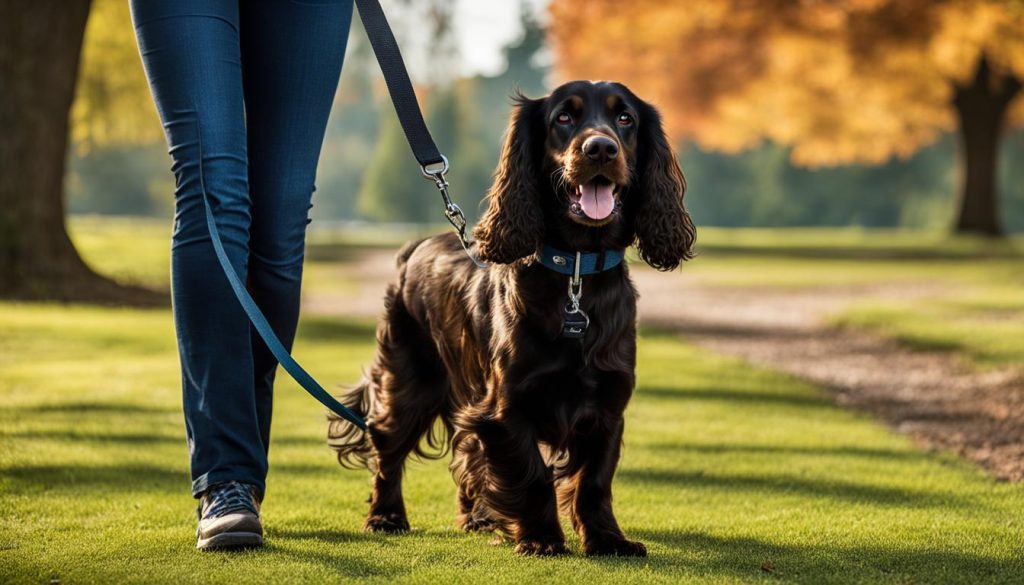
Training Tips for Problem Behaviors
Cocker Spaniels, like any other dog breed, may exhibit problem behaviors that require specific training methods to address. These behaviors can range from separation anxiety and destructive behavior when left alone to excessive barking or attention-seeking behaviors. Fortunately, there are effective training techniques available to help modify these behaviors and ensure a well-behaved Cocker Spaniel. Here are some training tips to consider:
Focusing on Building Independence and Managing Anxiety
If your Cocker Spaniel displays separation anxiety or destructive behavior when left alone, it is important to focus on building their independence and managing their anxiety. Gradual desensitization techniques can be used to help your dog become comfortable with being alone for increasingly longer periods of time. Start by leaving your dog alone for short intervals, gradually increasing the duration over time. Creating a safe and comforting environment with toys, treats, and familiar scents can also help alleviate anxiety.
Addressing Excessive Barking and Attention-Seeking Behaviors
Excessive barking and attention-seeking behaviors can be problematic for both you and your Cocker Spaniel. To tackle these issues, it is essential to establish clear boundaries and consistently reinforce positive behavior. Redirecting your dog’s attention to appropriate activities, such as interactive toys or training exercises, can be effective in keeping them engaged and reducing their desire to bark or seek attention. Additionally, providing mental and physical stimulation through activities like daily walks and puzzle toys can help prevent boredom-related behaviors.
Seeking Professional Guidance and Support
In some cases, behavior modification techniques may require professional guidance and support. Certified dog trainers and behaviorists are equipped with the knowledge and experience to develop personalized training plans tailored to your Cocker Spaniel’s specific needs. They can provide valuable insights, strategies, and exercises to address problem behaviors effectively. Remember, seeking professional assistance is never a sign of failure, but rather a proactive step towards creating a harmonious relationship with your furry friend.
By implementing these English Cocker Spaniel training tips, you can effectively address problem behaviors in your Cocker Spaniel and promote a positive and well-behaved companion. Remember to be patient, consistent, and always use positive reinforcement methods to encourage desired behavior. With time and effort, you can help your Cocker Spaniel become a confident and obedient member of your family.
Conclusion
English Cocker Spaniel training can be a rewarding and fulfilling experience for both the owner and the dog. Through effective training methods and an understanding of the breed’s unique qualities, owners can successfully teach their English Cocker Spaniels obedience and good behavior.
Positive reinforcement training techniques, such as using treats and rewards, have proven to be highly effective in motivating and shaping the behavior of Cocker Spaniels. Consistency and patience are crucial in the English Cocker Spaniel training process, as it may take time for the dog to fully grasp and respond to the commands.
By following the tips and techniques outlined in this article, owners can create a strong bond with their Cocker Spaniels and ensure they become well-mannered companions. However, it is important to note that each dog is unique, and some may require professional training assistance for specific issues or behaviors.
If you are seeking additional guidance or facing challenges in training your Cocker Spaniel, consider consulting a professional trainer or behaviorist who specializes in working with this breed. They can provide tailored advice and support to help you overcome any training obstacles and achieve desired results.
FAQ
Can you provide some tips for effective English Cocker Spaniel training?
Absolutely! English Cocker Spaniels are intelligent and eager to please, making them easy to train. Positive reinforcement training methods, such as using treats and clicker training, work well with this breed. Consistency and patience are key throughout the training process. It’s also important to invest in the right equipment, such as a treat pouch, collar, harness, leash, and crate.
What are some basic commands that I should teach my Cocker Spaniel?
Teaching your Cocker Spaniel basic commands is essential for their obedience. Some important commands to start with include sit, lie down, come, walk nicely on a leash, play fetch, sleep in a crate, cope with being left alone, and go to the bathroom in the right place. Positive reinforcement techniques, such as using treats and clicker training, can be effective in teaching these commands.
How important is socialization for Cocker Spaniels?
Socialization is crucial for Cocker Spaniels from an early age. Exposing them to different people, animals, and environments helps them develop good behavior and communication skills. It’s best to start puppy socialization as soon as they are brought home. This includes introducing them to various experiences and teaching basic commands to establish a routine.
What are some tips for crate and house training Cocker Spaniels?
Crate training is valuable for housebreaking and providing a safe space for Cocker Spaniels. The crate should be made comfortable and inviting, and the training process should be introduced gradually. House training requires consistency and a regular schedule for taking the puppy outside to go to the bathroom. Positive reinforcement should be used to reward desired behavior and discourage accidents indoors.
How can I leash train my Cocker Spaniel and teach them obedience commands?
Leash training is essential for teaching Cocker Spaniels to walk nicely on a leash without pulling. The process involves getting the puppy comfortable with wearing a collar and gradually introducing the leash. Obedience commands, such as sit, stay, and come, can be taught using positive reinforcement techniques. Consistency and repetition are key in reinforcing these commands and ensuring the dog understands and responds appropriately.
What should I do if my Cocker Spaniel exhibits problem behaviors?
If your Cocker Spaniel displays problem behaviors, such as separation anxiety or excessive barking, specific training methods can address these issues. Techniques focused on building independence and managing anxiety can help with separation anxiety. Behavior modification techniques can be used to address excessive barking or attention-seeking behaviors. Professional trainers and behaviorists can provide guidance and support in training Cocker Spaniels with problem behaviors.
How effective is training for English Cocker Spaniels?
English Cocker Spaniels are intelligent and trainable dogs that respond well to positive reinforcement training methods. Consistency, patience, and understanding the unique qualities of the breed are key factors in successful training. Following the tips and techniques outlined in this article can enhance your Cocker Spaniel’s obedience and behavior, creating a strong bond and a well-mannered companion. Professional training assistance is also available for owners seeking additional guidance.


